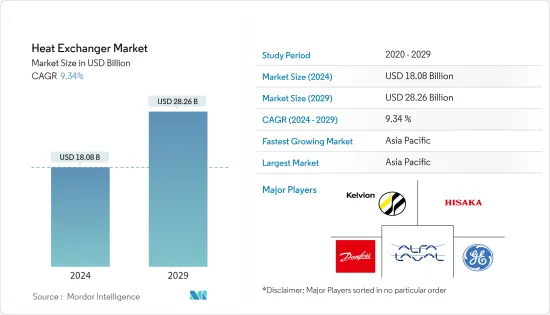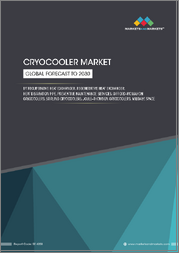
|
시장보고서
상품코드
1536854
열교환기 : 시장 점유율 분석, 산업 동향 및 통계, 성장 예측(2024-2029년)Heat Exchanger - Market Share Analysis, Industry Trends & Statistics, Growth Forecasts (2024 - 2029) |
||||||
■ 보고서에 따라 최신 정보로 업데이트하여 보내드립니다. 배송일정은 문의해 주시기 바랍니다.
전 세계 열교환기(Heat Exchanger) 시장 규모는 2024년 180억 8,000만 달러에 달할 것으로 예상되고, 2024-2029년의 예측 기간 동안 CAGR 9.34%로 성장하여 2029년에는 282억 6,000만 달러에 달할 것으로 예측됩니다.

주요 하이라이트
- 중기적으로는 산업용도 증가, 확장, 신발전소 시장 개척이 예측기간 중 시장을 견인할 것으로 보입니다.
- 한편, 열교환기를 거의 필요로 하지 않는 재생 가능 에너지 증가는 시장에 부정적인 영향을 미칠 것으로 예상됩니다.
- 그러나 중국과 인도와 같은 신흥 국가에서 산업화와 도시화의 발전은 더 많은 발전을 필요로 하기 때문에 열교환기 시장에서 호기심이 될 것으로 예상됩니다.
- 아시아 태평양은 중국, 일본, 한국, 인도의 산업 개척 증가로 열교환기 시장을 독점할 것으로 예상됩니다.
열교환기 시장 동향
발전이 시장을 독점할 전망
- 발전 부문은 일반 가정과 산산업로부터 전력 수요가 증가함에 따라 시장을 독점할 것으로 예상됩니다. 예측 기간 동안 이 부문은 열교환기 시장을 독점할 수도 있습니다.
- 열교환기는 화석 에너지 및 열 에너지에 의한 발전에 널리 사용됩니다. 발전소에서는 고온 배기 가스로부터 열을 수집하고 발전하기 위해 열교환기가 사용됩니다. 에너지 분야에서 수요 증가는 예측 기간 동안 열교환기 시장을 밀어올릴 수 있습니다.
- 에너지정보국에 따르면 미국의 총 발전량은 2023년 4,178테라와트시(TWh)를 차지했습니다. 전년에 비해 발전량은 50TWh 감소했지만 도시화의 진전에 따라 전력 수요는 앞으로 더욱 증가할 것으로 예상됩니다.
- 원자력발전소에서는 열교환기가 1차측(원자로)에서 2차측의 증기발생기로 열을 전달하고 있습니다. 2024년 4월, 아랍에미리트(UAE)은 걸프 소국의 원자로를 두배로 늘리는 새로운 원자력 발전소 건설 입찰을 발표한다고 발표했습니다. 이러한 프로젝트는 전력 부문에서 열교환기 수요를 높이는 것으로 보입니다.
- 따라서 이러한 프로젝트는 예측 기간 동안 열교환기 시장에 긍정적인 영향을 미칠 것으로 보입니다.
아시아 태평양이 시장을 독점할 전망
- 아시아 태평양은 과거에 열교환기 시장을 독점했습니다. 건설중인 여러 전력 프로젝트로 인해 예측 기간 동안 시장을 독점 할 가능성이 높습니다.
- 7월 현재 중국에서는 1,142기의 석탄화력발전소가 가동되고 있으며, 정부는 더욱 큰 석탄화력발전소를 건설할 계획입니다. 이 요인은 이 나라의 열교환기 수요를 촉진할 것으로 예상됩니다.
- 여러 열교환기 제조업체들이 지역 프레즌스를 확대하기 위해 투자를 하고 있으며, 이는 시장을 견인할 것으로 예상됩니다. 2023년 6월, 공기열교환기 분야에서 세계 최대의 사업자인 LU-VE Group은 LU-VE 천문 생산공장을 확장하여 천문현(중국 후베이성)과 합의했습니다.
- 또한 NTPC는 올해 중 석탄발전소 추가 건설을 시작할 예정입니다. 이 나라는 늘어나는 에너지 수요를 충족시키기 위해 계속해서 연료에 의존하고 있습니다. 뉴델리에 본사를 두고 있는 NTPC는 약 4.5기가톤의 석탄화력발전소 건설계약을 체결할 예정입니다.
- 또한 향후 인도나 중국과 같은 국가들이 원자력발전소의 신설에 힘을 쏟아 갈수록 열교환기 시장 수요가 높아질 것으로 보입니다. 예를 들어, 2023년 5월, Nuclear Power Corporation of India Ltd는 인도의 두 사이트에서 6개의 700메가와트 가압 수형 중수로(PHWR)를 개발하기로 합의했습니다.
- 따라서 이러한 프로젝트는 예측 기간 동안 아시아 태평양 열교환기 시장을 견인할 것으로 예상됩니다.
열교환기 산업 개요
열교환기 시장은 적당히 세분화됩니다. 이 시장의 주요 기업으로는 Alfa Laval AB, Danfoss AS, General Electric Company, Hisaka Works Ltd, Kelvion Holding GmbH 등이 있습니다.
기타 혜택 :
- 엑셀 형식 시장 예측(ME) 시트
- 3개월간의 애널리스트 서포트
목차
제1장 서론
- 조사 범위
- 시장 정의
- 조사 전제
제2장 주요 요약
제3장 조사 방법
제4장 시장 개요
- 소개
- 시장 규모 및 수요 예측(-2029년)(10억 달러)
- 최근 동향 및 전개
- 정부 규제 및 정책
- 시장 역학
- 성장 촉진요인
- 세계의 산업화의 진전
- 새로운 발전소 확장 및 개발
- 억제요인
- 신재생에너지 도입 증가
- 성장 촉진요인
- 공급망 분석
- Porter's Five Forces 분석
- 공급기업의 협상력
- 소비자의 협상력
- 신규 진입업자의 위협
- 대체품의 위협
- 경쟁 기업간 경쟁 관계의 강도
제5장 시장 세분화
- 건설 유형
- 쉘·튜브
- 플레이트 프레임
- 기타 건설 유형
- 최종 사용자
- 석유 및 가스 산업
- 발전
- 화학
- 식품·음료
- 기타 최종 사용자
- 지역
- 북미
- 미국
- 캐나다
- 멕시코
- 기타 북미
- 유럽
- 영국
- 독일
- 프랑스
- 러시아
- 노르딕
- 이탈리아
- 스페인
- 기타 유럽
- 아시아 태평양
- 인도
- 중국
- 일본
- 호주
- 태국
- 인도네시아
- 말레이시아
- 기타 아시아 태평양
- 남미
- 브라질
- 아르헨티나
- 콜롬비아
- 기타 남미
- 중동 및 아프리카
- 아랍에미리트(UAE)
- 사우디아라비아
- 카타르
- 나이지리아
- 남아프리카공화국
- 이집트
- 기타 중동 및 아프리카
- 북미
제6장 경쟁 구도
- 합병·인수, 합작 사업, 제휴, 협정
- 주요 기업의 전략
- 기업 프로파일
- Alfa Laval AB
- Barriquand Technologies Thermiques SAS
- Danfoss AS
- General Electric Company
- Hisaka Works Ltd
- Mersen SA
- Thermax Limited
- SPX Flow Inc.
- Kelvion Holding GmbH
- 시장 랭킹 점유율(%) 분석
제7장 시장 기회 및 향후 동향
- 열교환기 개발 관련 기술 진보
The Heat Exchanger Market size is estimated at USD 18.08 billion in 2024, and is expected to reach USD 28.26 billion by 2029, growing at a CAGR of 9.34% during the forecast period (2024-2029).

Key Highlights
- Over the medium term, increasing industrial applications, expansions, and the development of new power plants will likely drive the market during the forecast period.
- On the other hand, increasing renewable energy, which rarely requires a heat exchanger, is expected to impact the market negatively.
- However, increasing industrialization and urbanization in developing countries, such as China and India, require more power generation, which is expected to create an opportunity for the heat exchanger market.
- Asia-Pacific is expected to dominate the heat exchanger market due to its increasing industrial development in China, Japan, South Korea, and India.
Heat Exchanger Market Trends
Power Generation Expected to Dominate the Market
- The power generation segment is expected to dominate the market due to the increasing demand for electricity from households and industrial operations. This segment may also dominate the heat exchanger market during the forecast period.
- Heat exchangers are widely used in power generation through fossil and thermal energy. Power generation plants employ heat exchangers to collect heat from hot waste gases to generate power. The growing demand in the energy sector may boost the heat exchanger market during the forecast period.
- According to the Energy Information Administration, the total electricity generation in the United States accounted for 4,178 terawatt-hours (TWh) in 2023. Compared to the previous year, power generation decreased by 50 TWh, but with increasing urbanization, the electricity demand is expected to grow further in the coming years.
- In a nuclear power plant, heat exchangers transfer heat from the primary side (reactor) to the secondary side steam generator. In April 2024, the United Arab Emirates announced that it would release a tender for constructing a new nuclear power plant that would double the small Gulf state's nuclear reactors. Such projects will boost the demand for heat exchangers in the power sector.
- Hence, such projects will positively impact the heat exchanger market during the forecast period.
Asia-Pacific Expected to Dominate the Market
- Asia-Pacific dominated the heat exchanger market in the past. It will likely dominate the market during the forecast period due to several power projects under construction.
- As of July 2023, China had 1,142 operational coal power plants, and the government plans to include more large-scale coal-fired power plants. This factor is expected to drive the country's demand for heat exchangers.
- Several heat exchanger companies are investing to expand their regional presence, which is expected to drive the market. In June 2023, LU-VE Group, the world's largest operator in the field of air heat exchangers, agreed with Tianmen Prefecture (Hubei Province, China) to expand the LU-VE Tianmen production plant.
- Additionally, NTPC Ltd intends to begin the construction of additional coal plants this year. The country continues to rely on fuel to meet its expanding energy needs. The New Delhi-based NTPC is expected to award building contracts for approximately 4.5 gigatonnes of coal-fired capacity.
- Further, in the upcoming period, the market for heat exchangers will be in demand as countries like India and China focus on building new nuclear power plants. For example, in May 2023, Nuclear Power Corporation of India Ltd agreed to develop six 700 MW pressurized heavy water reactors (PHWRs) across two sites in India.
- Hence, such projects are expected to drive the Asia-Pacific heat exchanger market during the forecast period.
Heat Exchanger Industry Overview
The heat exchanger market is moderately fragmented. The key players in the market include (in no particular order) Alfa Laval AB, Danfoss AS, General Electric Company, Hisaka Works Ltd, and Kelvion Holding GmbH.
Additional Benefits:
- The market estimate (ME) sheet in Excel format
- 3 months of analyst support
TABLE OF CONTENTS
1 INTRODUCTION
- 1.1 Scope of the Study
- 1.2 Market Definition
- 1.3 Study Assumptions
2 EXECUTIVE SUMMARY
3 RESEARCH METHODOLOGY
4 MARKET OVERVIEW
- 4.1 Introduction
- 4.2 Market Size and Demand Forecast in USD billion, till 2029
- 4.3 Recent Trends and Developments
- 4.4 Government Policies and Regulations
- 4.5 Market Dynamics
- 4.5.1 Drivers
- 4.5.1.1 Increasing Industrialization across the World
- 4.5.1.2 Expansion and Development of New Power Plants
- 4.5.2 Restraints
- 4.5.2.1 Increasing Adoption of Renewable Energy
- 4.5.1 Drivers
- 4.6 Supply Chain Analysis
- 4.7 Porter's Five Forces Analysis
- 4.7.1 Bargaining Power of Suppliers
- 4.7.2 Bargaining Power of Consumers
- 4.7.3 Threat of New Entrants
- 4.7.4 Threat of Substitute Products and Services
- 4.7.5 Intensity of Competitive Rivalry
5 MARKET SEGMENTATION
- 5.1 Construction Type
- 5.1.1 Shell and Tube
- 5.1.2 Plate Frame
- 5.1.3 Other Construction Types
- 5.2 End User
- 5.2.1 Oil and Gas Industry
- 5.2.2 Power Generation
- 5.2.3 Chemical
- 5.2.4 Food and Beverages
- 5.2.5 Other End Users
- 5.3 Geography
- 5.3.1 North America
- 5.3.1.1 United States
- 5.3.1.2 Canada
- 5.3.1.3 Mexico
- 5.3.1.4 Rest of North America
- 5.3.2 Europe
- 5.3.2.1 United Kingdom
- 5.3.2.2 Germany
- 5.3.2.3 France
- 5.3.2.4 Russia
- 5.3.2.5 NORDIC
- 5.3.2.6 Italy
- 5.3.2.7 Spain
- 5.3.2.8 Rest of Europe
- 5.3.3 Asia-Pacific
- 5.3.3.1 India
- 5.3.3.2 China
- 5.3.3.3 Japan
- 5.3.3.4 Australia
- 5.3.3.5 Thailand
- 5.3.3.6 Indonesia
- 5.3.3.7 Malaysia
- 5.3.3.8 Rest of Asia-Pacific
- 5.3.4 South America
- 5.3.4.1 Brazil
- 5.3.4.2 Argentina
- 5.3.4.3 Colombia
- 5.3.4.4 Rest of South America
- 5.3.5 Middle East and Africa
- 5.3.5.1 United Arab Emirates
- 5.3.5.2 Saudi Arabia
- 5.3.5.3 Qatar
- 5.3.5.4 Nigeria
- 5.3.5.5 South Africa
- 5.3.5.6 Egypt
- 5.3.5.7 Rest of the Middle East and Africa
- 5.3.1 North America
6 COMPETITIVE LANDSCAPE
- 6.1 Mergers and Acquisitions, Joint Ventures, Collaborations, and Agreements
- 6.2 Strategies Adopted by Leading Players
- 6.3 Company Profiles
- 6.3.1 Alfa Laval AB
- 6.3.2 Barriquand Technologies Thermiques SAS
- 6.3.3 Danfoss AS
- 6.3.4 General Electric Company
- 6.3.5 Hisaka Works Ltd
- 6.3.6 Mersen SA
- 6.3.7 Thermax Limited
- 6.3.8 SPX Flow Inc.
- 6.3.9 Kelvion Holding GmbH
- 6.4 Market Ranking/Share (%) Analysis
7 MARKET OPPORTUNITIES AND FUTURE TRENDS
- 7.1 Technological Advancements in Developing Heat Exchangers
샘플 요청 목록



















